Optimization of the Mechanical and Corrosion Resistance of Alloy 625 through Aging Treatments
Abstract
1. Introduction
2. Materials and Methods
3. Results and Discussion
3.1. Soft-Annealed Condition
3.2. Single- and Double-Aging Treatments
4. Conclusions
- The soft-annealed material was associated with acceptable corrosion resistance but insufficient mechanical strength because of excessive grain growth;
- Excessively long aging exposures can activate the simultaneous formation of intermetallic phases and intergranular carbides. According to the SEM and EDXS observations, when chromium-rich carbides precipitated, sensitization was obtained. This negative effect was limited by the reduced aging temperature and time;
- With single aging at 732 °C, the hardening effect is poor, and 16 h is required to exceed the minimum hardness requirement. However, at this exposure, the corrosion rate is not acceptable;
- Only single aging at 621 °C for 72 h resulted in acceptable mechanical and corrosion properties. However, since the hardness is very close to the limit value estimated for acceptability, further investigation of longer aging times is necessary and will be considered in a future development of this work;
- The double-aging procedure allows precipitation to be accelerated due to the primary aging treatment, which promotes the nucleation and growth of subcritical nuclei. This triggering effect is necessary to reduce the overall heat treatment time, which would be significantly longer in the case of single aging at 621 °C without prior nucleation treatment. However, excessively long primary aging times do not provide any appreciable further acceleration of the age-hardening response;
- Primary aging is the most critical step for the resulting corrosion resistance. Even after optimization in terms of both temperature and time, none of the tested conditions were acceptable. A decrease in the primary aging temperature is useful for delaying the precipitation of intergranular carbides, but a weaker acceleration in the age-hardening response is obtained. An excessive reduction in the primary aging time is commonly not compatible with industrial applications involving large components;
- The Larson–Miller parameter was adopted in the regression model to combine the effects of the primary aging time and temperature. The double-aging process fraction curves for the hardness were modeled as a function of the Larson–Miller parameter for each tested secondary aging time, resulting in a good fit. This analysis revealed that for each curve, the steady-state hardness value was dependent on the secondary aging time.
Author Contributions
Funding
Data Availability Statement
Acknowledgments
Conflicts of Interest
References
- Suave, L.M.; Cormier, J.; Villechaise, P.; Soula, A.; Hervier, Z.; Bertheau, D.; Laigo, J. Microstructural Evolutions During Thermal Aging of Alloy 625: Impact of Temperature and Forming Process. Metall. Mater. Trans. A 2014, 45, 2963–2982. [Google Scholar] [CrossRef]
- Shankar, V.; Rao, K.B.S.; Mannan, S.L. Microstructure and mechanical properties of Inconel 625 superalloy. J. Nucl. Mater. 2001, 288, 222–232. [Google Scholar] [CrossRef]
- Sukumaran, A.; Gupta, R.K.; Kumar, V.A. Effect of Heat Treatment Parameters on the Microstructure and Properties of Inconel-625 Superalloy. J. Mater. Eng. Perform. 2017, 26, 3048–3057. [Google Scholar] [CrossRef]
- Heubner, U.; Kloewer, J.; Alves, H.; Behrens, R.; Schindler, C.; Wahl, V.; Wolf, M. Nickel Alloys and High-Alloyed Special Stainless Steels: Properties-Manufacturing-Applications, 4th ed.; Expert-Verlag: Renningen, Germany, 2012. [Google Scholar]
- ASM International. ASM Specialty Handbook: Nickel, Cobalt, and Their Alloys; ASM International: Materials Park, OH, USA, 2000. [Google Scholar]
- Donachie, M.J.; Donachie, S.J. Superalloys: A Technical Guide, 2nd ed.; ASM International: Materials Park, OH, USA, 2002. [Google Scholar]
- Eiselstein, H.L.; Tillack, D.J. The Invention and Definition of Alloy 625. In Proceedings on Superalloys 718, 625, and Derivatives; Loria, E.A., Ed.; The Minerals, Metals & Materials Society: Pittsburgh, PA, USA, 1991; pp. 1–14. [Google Scholar]
- Durand-Charre, M. The Microstructure of Superalloys, 1st ed.; Routledge: London, UK, 1968. [Google Scholar]
- Floreen, S.; Fuchs, G.E.; Yang, W.J. The Metallurgy of Alloy 625. In Superalloys 718, 625, 706 and Derivatives; The Minerals, Metals & Materials Society: Pittsburgh, PA, USA, 1994; pp. 13–37. [Google Scholar]
- Patel, S.J.; Smith, G.D. The Role of Niobium in Wrought Precipitation-Hardened Nickel-Base Alloys. In Proceedings on Superalloys 718, 625, 706 and Derivatives; Loria, E.A., Ed.; The Minerals, Metals & Materials Society: Pittsburgh, PA, USA, 2005; pp. 135–154. [Google Scholar]
- Rivolta, B.; Boniardi, M.V.; Gerosa, R.; Casaroli, A.; Panzeri, D.; Zordão, L.H.P. Alloy 625 Forgings: Thermo-Metallurgical Model of Solution-Annealing Treatment. J. Mater. Eng. Perform. 2022, 32, 5785–5797. [Google Scholar] [CrossRef]
- ASTM B446-19; Standard Specification for Nickel-Chromium-Molybdenum-Columbium Alloy (UNS N06625), Nickel-Chromium-Molybdenum-Silicon Alloy (UNS N06219), and Nickel-Chromium-Molybdenum-Tungsten Alloy (UNS N06650) Rod and Bar. ASTM International: Materials Park, OH, USA, 2019.
- VMD Metals International GmbH, VDM Alloy 625 Nicrofer 6020 hMo. 2018. Available online: https://www.vdm-metals.com/en/alloy625/ (accessed on 1 May 2020).
- Reed, R.C.; Rae, C.M.F. Physical Metallurgy of the Nickel-Based Superalloys. In Physical Metallurgy; Elsevier: Amsterdam, The Netherlands, 2014; pp. 2215–2290. [Google Scholar] [CrossRef]
- Liu, X.; Fan, J.; Zhang, P.; Cao, K.; Wang, Z.; Chen, F.; Liu, D.; Tang, B.; Kou, H.; Li, J. Influence of heat treatment on Inconel 625 superalloy sheet: Carbides, γ’’, δ phase precipitation and tensile deformation behavior. J. Alloys Compd. 2023, 930, 167522. [Google Scholar] [CrossRef]
- Yenusah, C.O.; Ji, Y.; Liu, Y.; Stone, T.W.; Horstemeyer, M.F.; Chen, L.-Q.; Chen, L. Three-dimensional Phase-field simulation of γ″ precipitation kinetics in Inconel 625 during heat treatment. Comput. Mater. Sci. 2021, 187, 110123. [Google Scholar] [CrossRef]
- Yu, L.-J.; Marquis, E.A. Precipitation behavior of Alloy 625 and Alloy 625 plus. J. Alloys Compd. 2019, 811, 151916. [Google Scholar] [CrossRef]
- Sundararaman, M.; Kumar, L.; Prasad, G.E.; Mukhopadhyay, P.; Banerjee, S. Precipitation of an intermetallic phase with Pt2Mo-type structure in alloy 625. Metall. Mater. Trans. A 1999, 30, 41–52. [Google Scholar] [CrossRef]
- Suave, L.M.; Bertheau, D.; Cormier, J.; Villechaise, P.; Soula, A.; Hervier, Z.; Laigo, J. Impact of microstructural evolutions during thermal aging of Alloy 625 on its monotonic mechanical properties. MATEC Web Conf. 2014, 14, 21001. [Google Scholar] [CrossRef]
- Vernot-Loier, C.; Cortial, F. Influence of Heat Treatments on Microstructure, Mechanical Properties and Corrosion Behaviour of Alloy 625 Forged Rod. In Proceedings on Superalloys 718, 625, and Derivatives; Loria, E.A., Ed.; The Minerals, Metals & Materials Society: Pittsburgh, PA, USA, 1991; pp. 409–422. [Google Scholar]
- Heubner, U.; Köhler, M. Effect of Carbon Content and Other Variables on Yield Strength, Ductility, and Creep Properties of Alloy 625. In Proceedings on Superalloys 718, 625, 706 and Derivatives; Loria, E.A., Ed.; The Minerals, Metals & Materials Society: Pittsburgh, PA, USA, 1994; pp. 479–488. [Google Scholar]
- Heubner, U.; Köhler, M. The effect of final heat treatment and chemical composition on sensitization, strength and thermal stability of alloy 625. In Proceedings on Superalloys 718, 625, 706 and Derivatives; The Minerals, Metals & Materials Society: Pittsburgh, PA, USA, 1997; pp. 795–803. [Google Scholar]
- Liu, M.; Zheng, W.; Xiang, J.; Song, Z.; Pu, E.; Feng, H. Grain Growth Behavior of Inconel 625 Superalloy. J. Iron Steel Res. Int. 2016, 23, 1111–1118. [Google Scholar] [CrossRef]
- Moore, I.J.; Taylor, J.I.; Tracy, M.W.; Burke, M.G.; Palmiere, E.J. Grain coarsening behaviour of solution annealed Alloy 625 between 600–800 °C. Mater. Sci. Eng. A 2017, 682, 402–409. [Google Scholar] [CrossRef]
- Guo, S.; Li, D.; Guo, Q.; Wu, Z.; Peng, H.; Hu, J. Investigation on hot workability characteristics of Inconel 625 superalloy using processing maps. J. Mater. Sci. 2012, 47, 5867–5878. [Google Scholar] [CrossRef]
- Chen, X.; Nie, L.-Y.; Hu, H.; Lin, Y.C.; Liu, Y.-X.; Wu, Z.-L.; Zhou, X.; Zhang, J.; Lu, X. High-temperature deformation characteristics and constitutive models of Inconel 625 superalloy. Mater. Today Commun. 2022, 32, 103855. [Google Scholar] [CrossRef]
- Jia, Z.; Gao, Z.; Ji, J.; Liu, D.; Guo, T.; Ding, Y. Study of the Dynamic Recrystallization Process of the Inconel 625 Alloy at a High Strain Rate. Materials 2019, 12, 510. [Google Scholar] [CrossRef] [PubMed]
- Carpenter Technology Corporation. CarTech® Custom Age 625 PLUS® Alloy: Technical Datasheet; Carpenter Technology Corporation: Pennvania, PA, USA, 2020; Available online: www.carpentertechnology.com/alloy-finder/625-Plus (accessed on 25 August 2020).
- Schmidt, N.B.; DeBold, T.A.; Frank, R.B. Custom age 625® plus alloy—A higher strength alternative to alloy 625. J. Mater. Eng. Perform. 1992, 1, 483–488. [Google Scholar] [CrossRef]
- ASTM G28-02; Standard Test Methods for Detecting Susceptibility to Intergranular Corrosion in Wrought, Nickel-Rich, Chromium-Bearing Alloys. ASTM International: Materials Park, OH, USA, 2015.
- E407-07; Standard Practice for Microetching Metals and Alloys. ASTM International: Materials Park, OH, USA, 2015.
- Carpenter Technology Corporation. A Guide to Etching Specialty Alloys for Microstructural Evaluation; Carpenter Technology Corporation: Pennvania, PA, USA, 2020; Available online: https://carpentertechnology.com/blog/a-guide-to-etching-specialty-alloys (accessed on 14 November 2023).
- ASTM E112-13; Standard Test Methods for Determining Average Grain Size. ASTM International: Materials Park, OH, USA, 2013. [CrossRef]
- ISO 6507-1:2018; Metallic Materials–Vickers Hardness Test. BSI Standards Publication: London, UK, 2018.
- BS EN ISO 6892-1:2019; Metallic materials-Tensile Testing. BSI Standards Publication: London, UK, 2020.
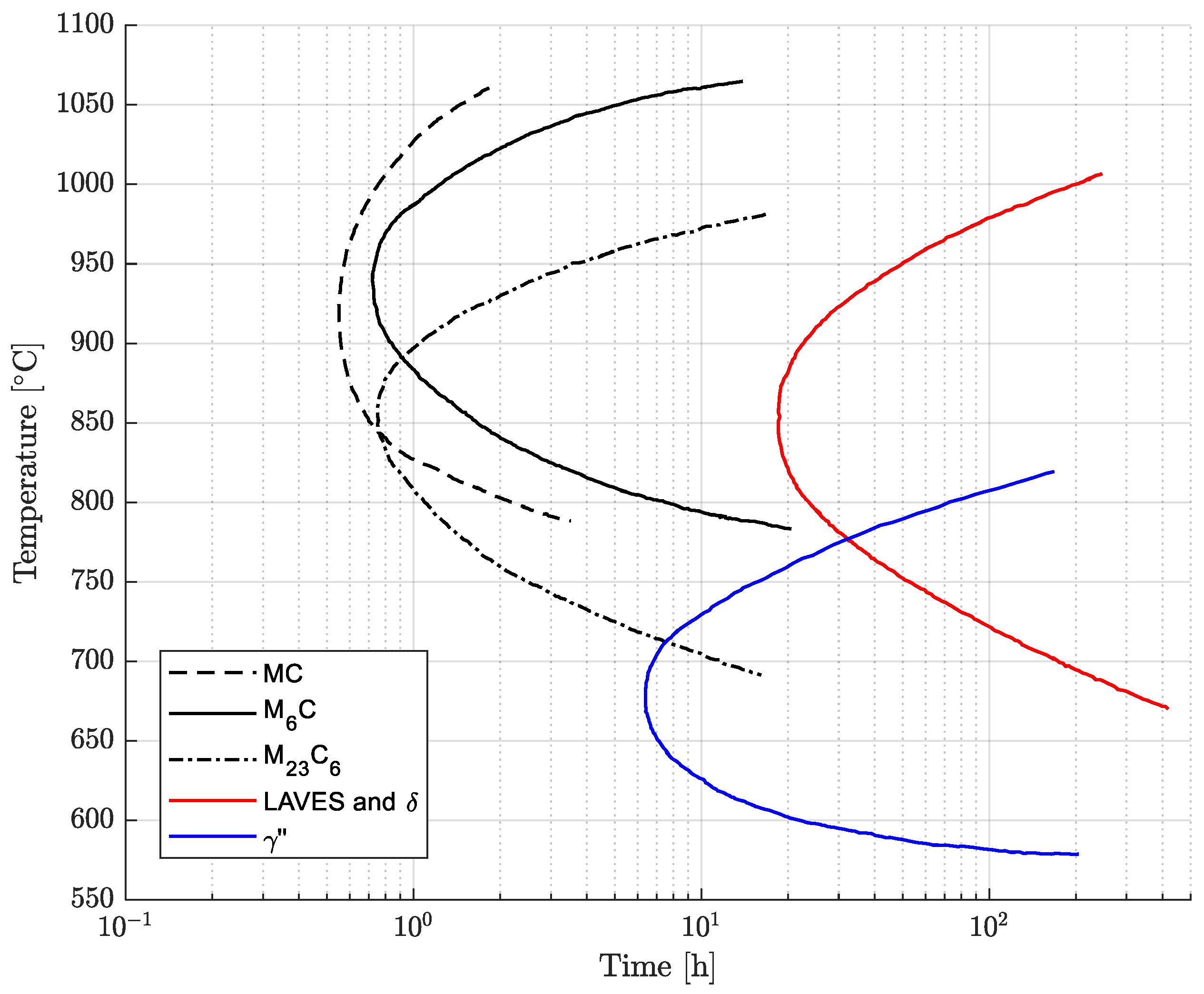

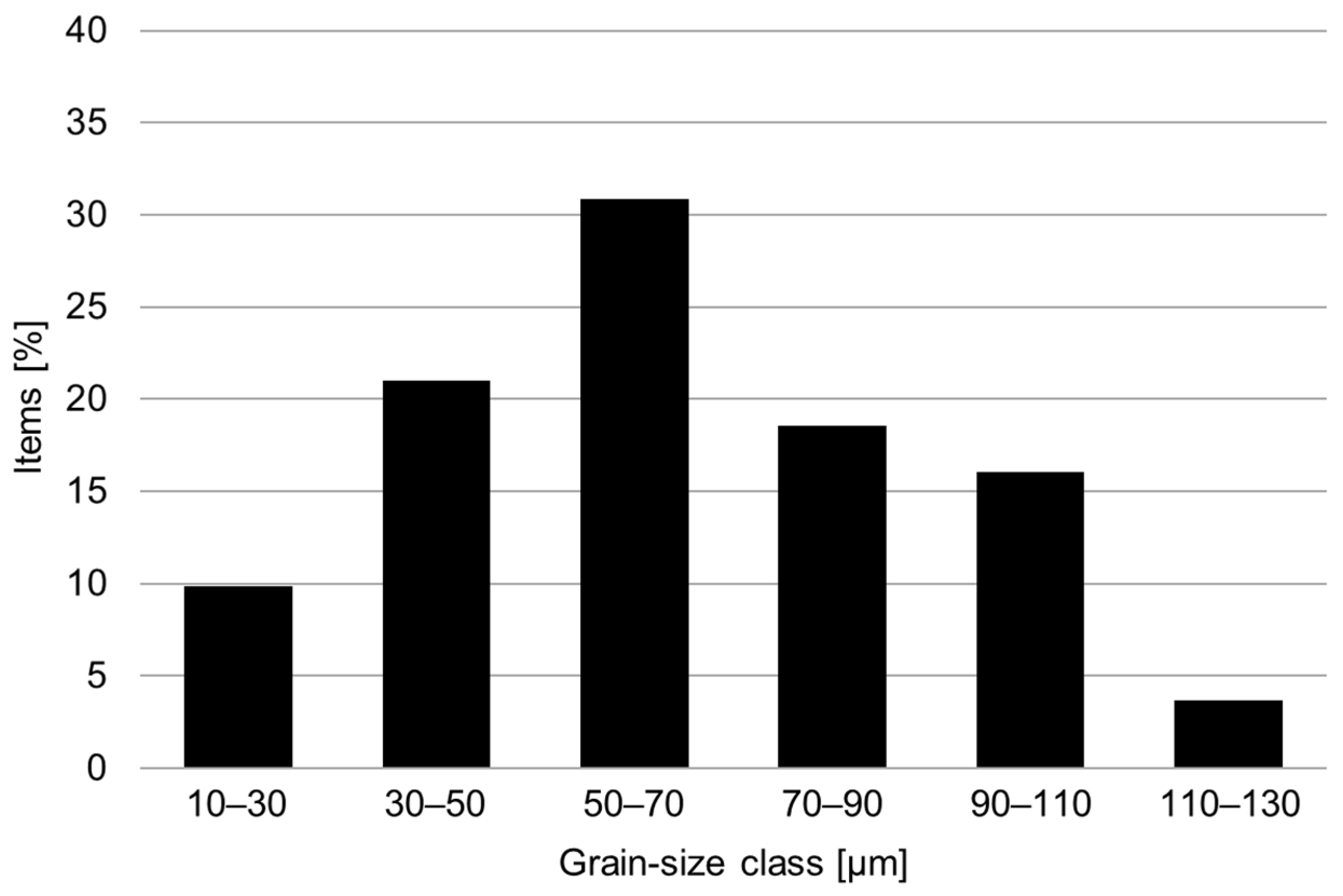





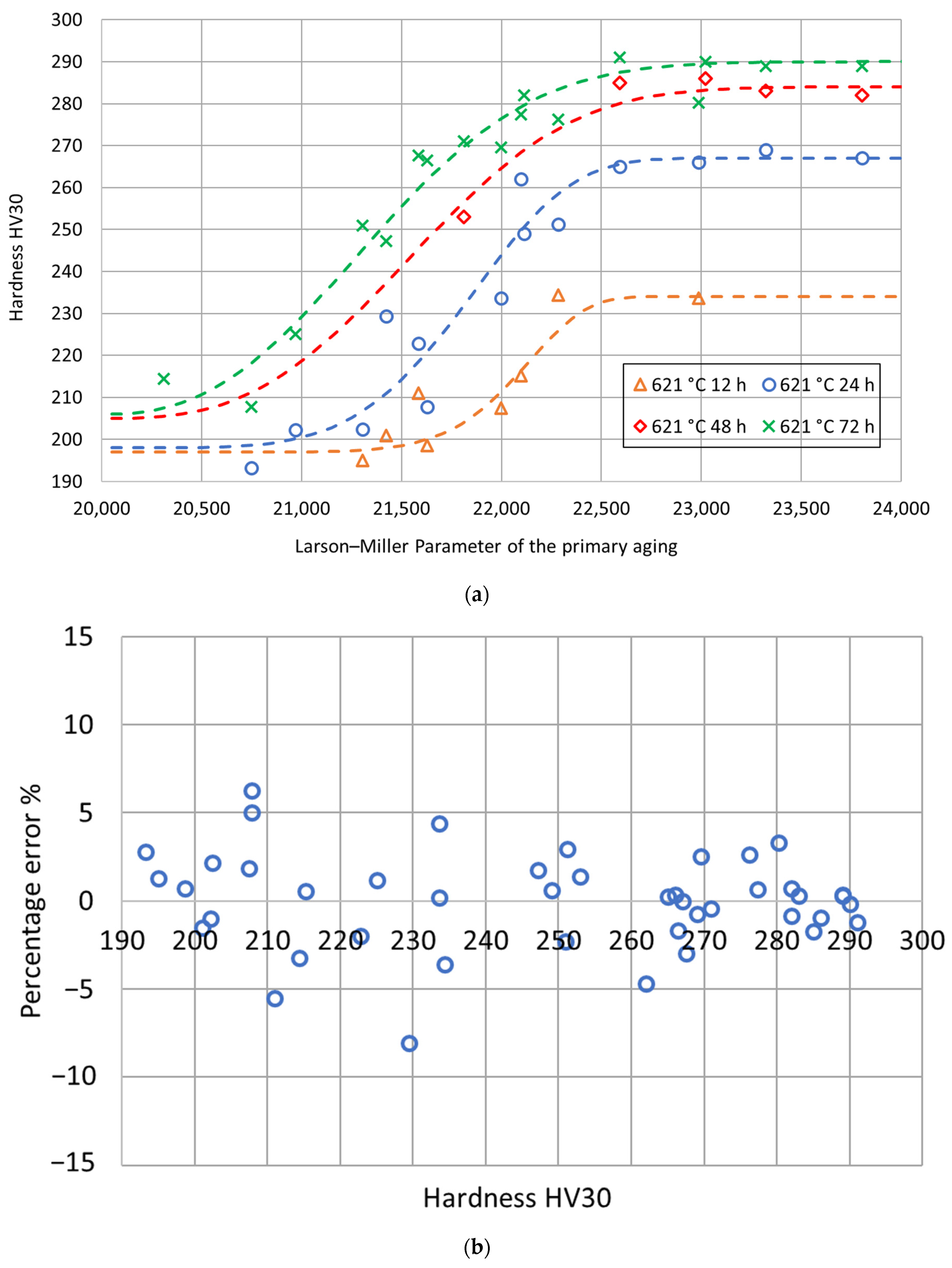


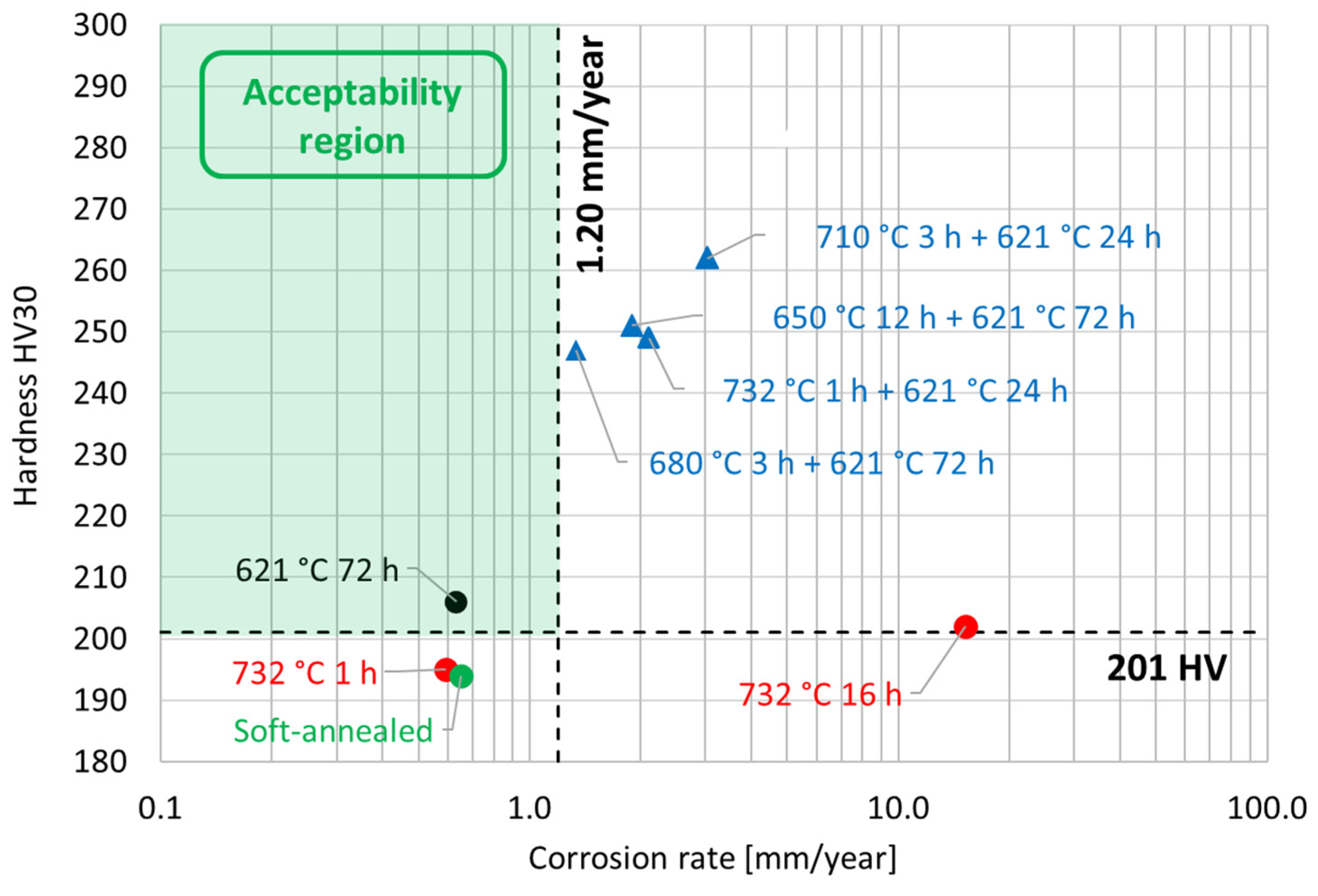
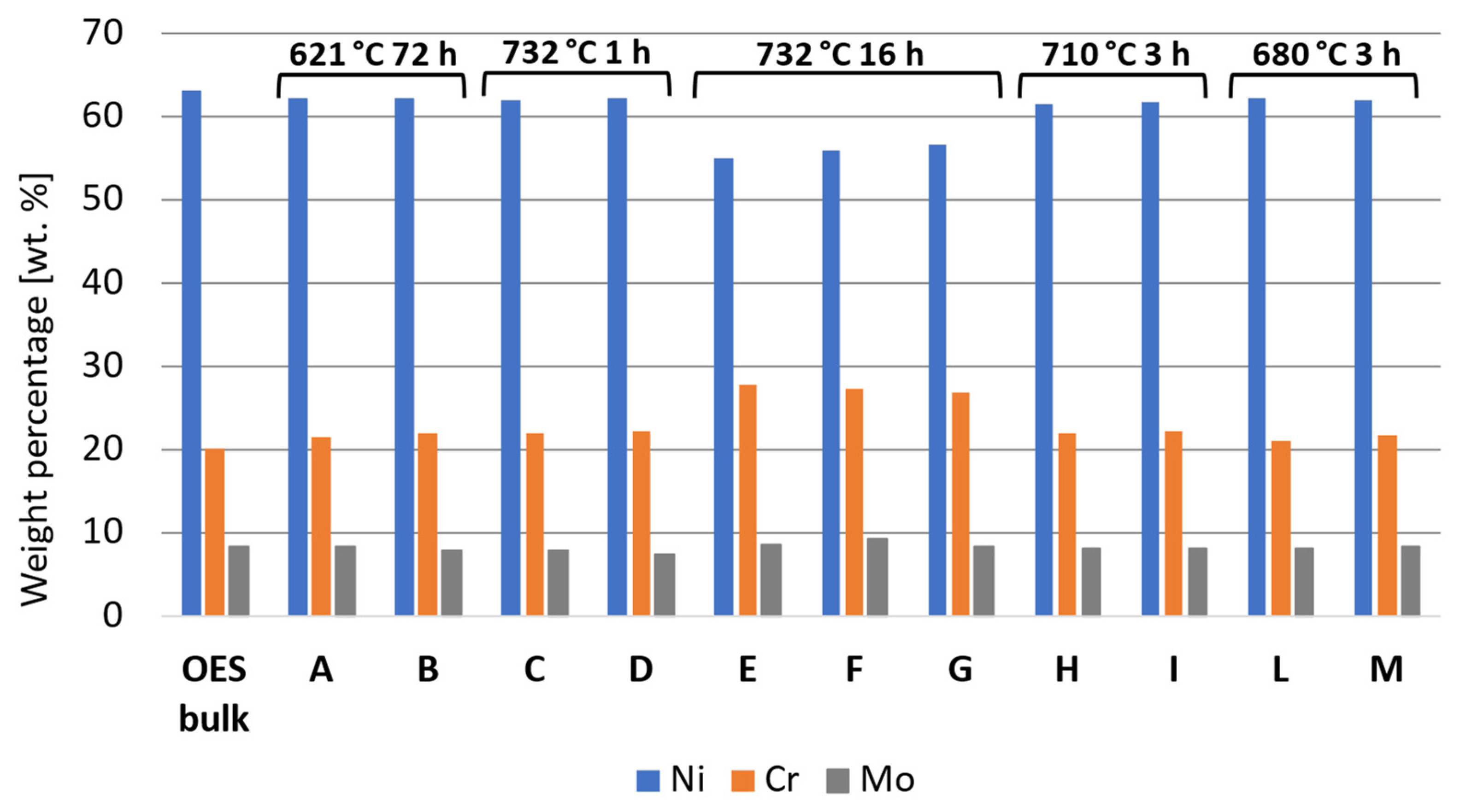


| Phase | Typical Composition |
|---|---|
| MC | Matrix blocky |
| (Cr0.04Fe0.02Ni0.09Nb0.75Mo0.03Ti0.07)C | |
| (Cr0.03Ni0.04Nb0.39Mo0.01Ti0.53)C | |
| Grain boundary | |
| (Cr0.04Fe0.01Ni0.08Nb0.67Mo0.01Ti0.15)C | |
| M6C | (Cr0.21Fe0.02Ni0.37Nb0.80Mo0.24Si0.08)6C |
| M23C6 | (Cr0.85Fe0.01Ni0.07Mo0.07)23C6 |
| Ni3(Nb>0.5Ti<0.5Al<0.5) | |
| Ni3Nb | |
| Ni2(Cr,Mo) | Ni0.63Cr0.30Mo0.07 |
| Laves | (Cr0.31Fe0.08Ni0.41)2(Si0.17Ti0.01Nb0.19Mo0.63) |
| (Cr,Nb)2N | (Cr0.39Nb0.41Ni0.07Mo0.13)2N |
| Ni | Cr | Mo | Nb | Fe | Mn | Ti | Al | C | Si | P | S | |
|---|---|---|---|---|---|---|---|---|---|---|---|---|
| wt. % | 63.2 | 20.1 | 8.32 | 3.51 | 4.32 | 0.07 | 0.28 | 0.22 | 0.03 | 0.14 | <0.01 | <0.01 |
| Hardness | YS [MPa] | UTS [MPa] | YS/UTS | A% | Z% | |
|---|---|---|---|---|---|---|
| This work | 194 HV30 | 350 | 829 | 0.42 | 61.0 | 70 |
| ASTM B446 | --- | >414 | >827 | --- | >30.0 | --- |
| [h] | ||||
|---|---|---|---|---|
| 12 | 197 | 234 | 3.6 × 10−29 | 8.5 |
| 24 | 198 | 267 | 7.7 × 10−17 | 4.9 |
| 48 | 205 | 284 | 3.8 × 10−10 | 2.9 |
| 72 | 206 | 290 | 1.0 × 10−8 | 2.5 |
| Figure | ID | Ni | Cr | Mo | Nb | Fe | Ti | Al | Si |
|---|---|---|---|---|---|---|---|---|---|
| Bulk (OES) | --- | 63.2 | 20.1 | 8.32 | 3.51 | 4.32 | 0.28 | 0.22 | 0.14 |
| Figure 13b | A | 62.1 | 21.5 | 8.21 | 3.20 | 4.41 | 0.26 | 0.16 | 0.16 |
| Figure 13b | B | 62.3 | 21.8 | 7.86 | 3.18 | 4.12 | 0.36 | 0.20 | 0.18 |
| Figure 13d | C | 61.9 | 22.0 | 7.78 | 2.96 | 4.53 | 0.31 | 0.37 | 0.15 |
| Figure 13d | D | 62.3 | 22.2 | 7.41 | 3.02 | 4.49 | 0.27 | 0.21 | 0.10 |
| Figure 13f | E | 55.1 | 27.7 | 8.61 | 4.15 | 3.74 | 0.34 | 0.15 | 0.21 |
| Figure 13f | F | 55.9 | 27.2 | 9.18 | 2.86 | 4.15 | 0.28 | 0.21 | 0.22 |
| Figure 13f | G | 56.5 | 26.7 | 8.22 | 3.55 | 4.34 | 0.31 | 0.19 | 0.19 |
| Figure 13h | H | 61.6 | 22.0 | 8.16 | 3.48 | 4.14 | 0.31 | 0.20 | 0.10 |
| Figure 13h | I | 61.7 | 22.2 | 7.95 | 3.21 | 4.37 | 0.27 | 0.18 | 0.17 |
| Figure 13j | L | 62.1 | 21.0 | 8.16 | 3.40 | 4.24 | 0.46 | 0.45 | 0.19 |
| Figure 13j | M | 62.0 | 21.6 | 8.21 | 3.38 | 4.08 | 0.31 | 0.24 | 0.18 |
Disclaimer/Publisher’s Note: The statements, opinions and data contained in all publications are solely those of the individual author(s) and contributor(s) and not of MDPI and/or the editor(s). MDPI and/or the editor(s) disclaim responsibility for any injury to people or property resulting from any ideas, methods, instructions or products referred to in the content. |
© 2024 by the authors. Licensee MDPI, Basel, Switzerland. This article is an open access article distributed under the terms and conditions of the Creative Commons Attribution (CC BY) license (https://creativecommons.org/licenses/by/4.0/).
Share and Cite
Rivolta, B.; Gerosa, R.; Panzeri, D.; Nazim, A. Optimization of the Mechanical and Corrosion Resistance of Alloy 625 through Aging Treatments. Crystals 2024, 14, 139. https://doi.org/10.3390/cryst14020139
Rivolta B, Gerosa R, Panzeri D, Nazim A. Optimization of the Mechanical and Corrosion Resistance of Alloy 625 through Aging Treatments. Crystals. 2024; 14(2):139. https://doi.org/10.3390/cryst14020139
Chicago/Turabian StyleRivolta, Barbara, Riccardo Gerosa, Davide Panzeri, and Arsalan Nazim. 2024. "Optimization of the Mechanical and Corrosion Resistance of Alloy 625 through Aging Treatments" Crystals 14, no. 2: 139. https://doi.org/10.3390/cryst14020139
APA StyleRivolta, B., Gerosa, R., Panzeri, D., & Nazim, A. (2024). Optimization of the Mechanical and Corrosion Resistance of Alloy 625 through Aging Treatments. Crystals, 14(2), 139. https://doi.org/10.3390/cryst14020139






